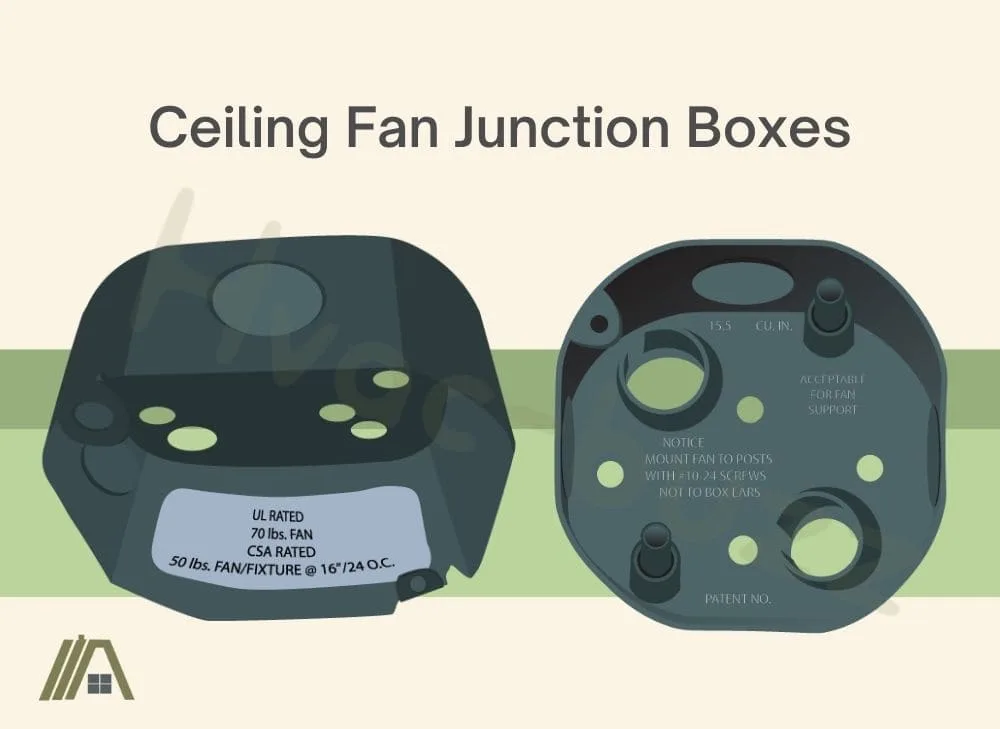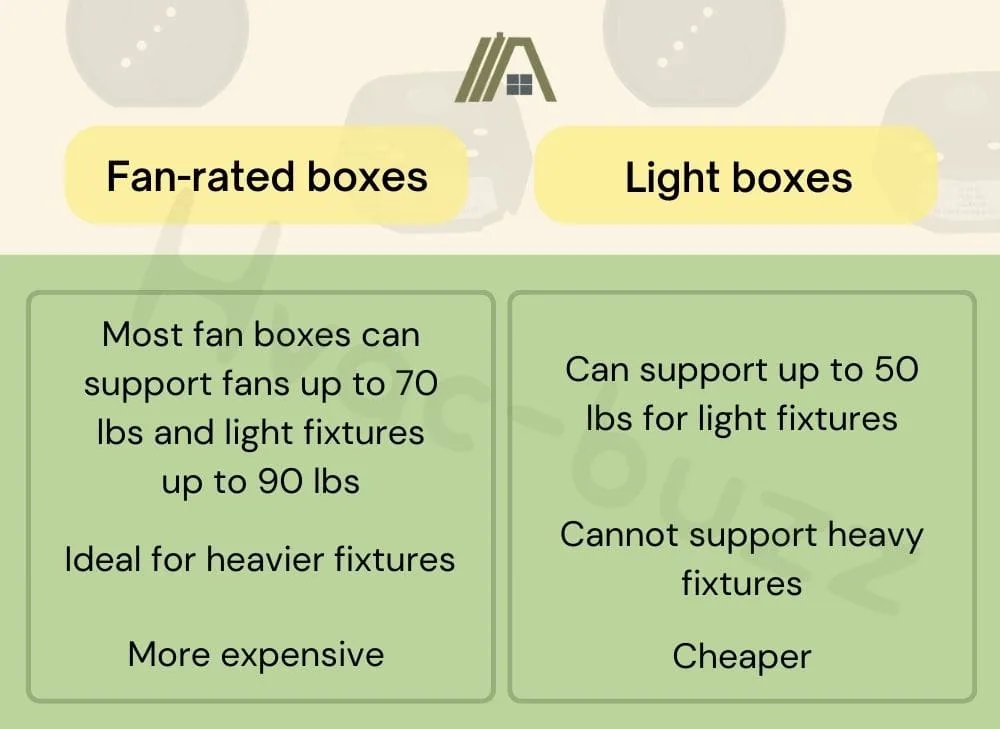
Ceiling fan boxes are designed to support heavier fixtures. They are designed in a way that allows them to be secured to a joist. Light boxes are only meant to support lighter fixtures, like light fittings. They can be screwed directly into drywall ceiling boards.
Difference Between Ceiling Fan and Light Boxes: Overview
Both ceiling fan boxes and light boxes perform the same function, albeit for different devices. They house electrical wires and support the weight of a fan or light.
The major difference between fan-rated boxes and light boxes is their weight-bearing capacity. Ceiling fan boxes are designed to support the weight and movement of a fan. Regular light boxes are designed for lighter and static fixtures.
What is a Ceiling Fan Box?
Ceiling fan junction boxes are electrical boxes that are rated for ceiling fan installation. They are used to house electrical wires are well as support the weight of the fan. They serve as the mounting surface to which the fan’s hanging bracket is attached.

Ceiling fan-rated boxes are usually round or octagonal. They come in different depth sizes, typically between 1/2 and 2 3/4 inches deep.
They are usually made of sturdy metal or durable plastic.
Weight It Can Handle
Ceiling fan boxes are designed to support more weight than regular junction boxes. Ceiling fan boxes are designed to support a minimum of 50 lbs.
Most ceiling fan electric boxes can support fans that weigh up to 70 lbs, which is more than the average weight of a ceiling fan, which typically ranges between 15 to 50 lbs. The extra weight-bearing capacity accounts for the centripetal force of rotation.
How Should It Be Supported?
Ceiling fan boxes need to be attached to a secure surface that can support the fan’s weight and movement. This is why fan boxes are attached to ceiling joists.
If the box is improperly installed to a joist or if it isn’t attached to one at all, the fan is at risk of wobbling or worse, collapsing.
How the box is installed would depend on the application and the installation location. The box can either be screwed directly to the joist or it can be connected to a brace that is attached to adjacent ceiling joists.
In situations where a brace is not available and there is attic access, a wooden block can be installed between the joists and the box screwed directly to the block.
Fans are secured with either 8-32 or 10-32 screws.
Required Ratings
The National Electric Code (NEC) demands that all ceiling fans that weigh 35 lbs and above be installed on an electric box that is listed for ceiling fan installation.
In accordance with the NEC, ceiling fan-rated boxes should be UL-listed for mounting ceiling fans. For a box to be listed for ceiling fan usage, it must meet the UL requirements, one of which is that it must have a minimum weight capacity of 50 lbs.
Details on whether a box is “approved for fan support” is usually provided on the packaging and on the box itself.
What is a Light Box?
Light junction boxes are electrical boxes that are approved for mounting light fixtures. They house wiring connections as well as support the weight of the lighting fixture.
There are different options to choose from when it comes to lighting electric boxes. Here are the most common light boxes:
- Octagon junction boxes (amazon link)
- Round junction boxes (amazon link)
- Round pan electric boxes (amazon link)
- Ceiling fan-rated boxes (amazon link)
Light boxes are usually made of metal or plastic and they come in different sizes ranging from 1/2 to 3 inches deep.
Weight It Can Handle
Light fixtures come in different forms and varying weights. The type of junction box used to mount a light fixture is usually dependent on the weight of the light.
Standard light boxes, like octagon boxes or round electric boxes, can support up to 50 lbs.
How Should It Be Supported?
How the junction box is mounted would be dependent on the box type. Some light boxes can be screwed to the drywall ceiling while others are secured to a joist.
Light fixtures are mostly secured with 8-32 screws.
Required Ratings
Light boxes do not require any formal listing like what is applicable in fan-rated electric boxes.
Lighting fixtures have a broad weight range. The requirement for light boxes is that they are suitable for the weight of whatever light fixture is to be installed on them.
Certain light fixtures like fluorescent tube-style lights, recessed lights, and some track lights come with special electric boxes and do not have to be mounted on a regular light box.
Table of Differences Between Ceiling Fan and Light Boxes
| Fan-rated boxes | Light boxes |
| Can be used for ceiling fans and light fixtures | Regular light boxes cannot support ceiling fans that weigh more than 35 pounds |
| Most fan boxes can support fans up to 70 lbs and light fixtures up to 90 lbs | Can support up to 50 lbs for light fixtures |
| Must be connected to joist | Can be screwed to drywall |
| Must be UL listed for ceiling fan installation | Doesn’t require UL listing |
| Sometimes come with a brace | Does not come with a brace |
| Ideal for heavier fixtures | Cannot support heavy fixtures |
| More expensive | Cheaper |

Is One Better Than The Other?
Light boxes are a brilliant choice as long as the static fixture is below 50 lbs and the ceiling fan is less than 35 lbs. Fixtures above 50 lbs have to be supported by a fan-rated box because they are better equipped to support heavier loads.
Additionally, although they might be able to support fans that weigh less than 35 lbs, most building codes demand that ceiling fans be mounted on fan-rated boxes,
Fan-rated boxes, on the other hand, are ideal for both ceiling fans and heavier light fixtures. Most fan-rated boxes come with weight ratings for ceiling fans and light fixtures.
For instance, this Bell (amazon link) ceiling fan box is rated to support ceiling fans that weigh up to 70 lbs and light fixtures weighing up to 150 lbs.
When you compare the features of fan-rated boxes and light boxes, it’s safe to say that ceiling fan boxes are the superior option.
Sources
https://www.thespruce.com/electrical-switch-and-junction-boxes-1824666
https://homeguides.sfgate.com/tell-existing-outlet-box-support-ceiling-fan-65443.html
https://www.hunker.com/13414278/how-to-install-a-light-fixture-if-there-is-no-electrical-box


